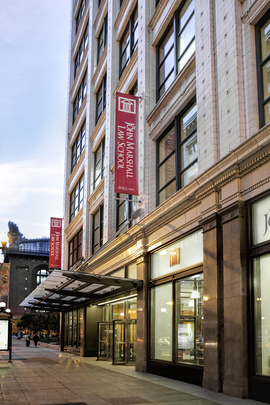You have /5 articles left.
Sign up for a free account or log in.

The University of Illinois at Chicago is poised to acquire the John Marshall Law School.
University of Illinois System
The University of Illinois at Chicago is poised to acquire the nearby John Marshall Law School after the University of Illinois Board of Trustees approved a plan Thursday that puts the transaction on track to close by next fall.
University leaders supported the deal, which was first revealed when it was in the discussion phase in November, as creating the only public law school in Chicago. The John Marshall Law School, founded in 1899, is currently a private nonprofit law school. Officials added that it will fill a hole at the University of Illinois at Chicago, arguing the institution was among a relatively small number of top-tier research universities without their own law schools.
More widely, the acquisition represents a burst of optimism at a time when public higher education in Illinois has been under intense budget pressure -- and when law schools have been struggling mightily to enroll students. It can be read as a reminder that complex merger-and-acquisition activity is possible in higher education even in suboptimal conditions.
But it also comes on the heels of an example showing that acquisitions don’t always work out as expected. Just last week, the University of Iowa announced it will close a branch campus it opened in Des Moines after receiving the campus three years ago as a gift from a closing business school.
Acquiring a working law school is very different from being given a closed campus, of course. Still, it’s noteworthy that two research universities in neighboring states are moving in opposite directions on M&A.
Adding a Chicago Law School
Skeptics could find reason to be wary of adding a law school at this particular moment in time. The number of law students nationally has dropped in recent years, schools have slimmed down and the American Bar Association has been more active publicly as an accreditor. The John Marshall Law School -- which is a distinct institution from several other similarly named law schools in the country -- is no different.
The private Chicago law school enrolled more than 1,466 students in 2012-13, according to American Bar Association reports. Enrollment fell to 938 in 2016-17. Applications dropped from 2,518 to 1,681 over the same period.
Leaders at Illinois Chicago, which has more than 30,000 students, were concerned about the state of law schools generally, said Susan Poser, a former law dean at the University of Nebraska who is UIC’s provost and vice chancellor for academic affairs. UIC administrators completed extensive due diligence, taking two years before proceedings reached the point of board approval Thursday.
“What we discovered was the John Marshall Law School was hit by this downturn, as just about everybody was,” she said. But, she added, the law school leaders were "very smart in how they downsized.”
The law school is operating at a surplus on a budget of about $40 million. It has cash on hand, Poser said. It owns attractive facilities -- four buildings in Chicago’s south Loop that have recently been renovated.
Officials don’t expect UIC, the University of Illinois System or the state to have to reallocate financial resources toward the law school. It’s expected to produce enough revenue from tuition to support its operations. That’s notable, because the state of Illinois has gone through significant budget battles in recent years that delayed funding for higher education. The budget is “back on track” now, according to Poser, but negotiations had to continue through the uncertainty.
Plus, the institutions’ academics line up, their campuses are only about 10 minutes away from each other and leaders think the combination will boost student access, affordability and joint- and dual-degree programs.
“We have tremendous enthusiasm from our faculty, not only about the opportunity this is creating for students, but also the opportunities it creates for them in research,” Poser said. “On the health side, we do a lot with population health and public health, social work, so we have all kinds of opportunities to create programs and collaborative research.”
Leaders also hope for crossover in fields like engineering and public affairs. About 40 full-time law school faculty would become University of Illinois at Chicago faculty members.
Under the terms of the deal, much of the law school’s cash and endowment assets will transfer to UIC. The law school’s legal entities will then wind down over five years or less, close, and any remaining assets will be transferred to the university.
The University of Illinois Foundation will use the endowment assets to benefit the law school. Leaders didn’t share financial details Thursday, with Poser saying only that the endowment to be transferred was in the “tens of millions.”
The deal is still subject to accreditor and regulatory approval. Leaders expect it to close by next July, and they anticipate enrolling the first new class after the law school transitions to a public institution in the fall of 2019. The institution will be named the UIC John Marshall Law School.
Tuition rates for the public law school haven’t yet been set but will be commensurate with other professional schools in the University of Illinois System, including in-state rates, according to Darby Dickerson, dean of the John Marshall Law School.
Dickerson, who previously held deanships at both the public Texas Tech University School of Law and the private Stetson University College of Law, took over as John Marshall dean at the beginning of 2017. Talks between the law school and UIC were already under way when she was interviewing, she said.
UIC approached the law school, but its board was not forced into a merger, Dickerson said.
“They understood that this transaction was one that would allow everything good about the institution to continue well into the future without worrying about market fluctuations and other challenges that independents have at different levels than law schools in universities,” Dickerson said.
At Thursday’s board meeting, UIC president Michael D. Amiridis recounted several past acquisitions through which the university traces its roots to pharmacy, medical and dentistry schools. The last was the dentistry school, in 1913.
“We took a break for 105 years, but here we are again today,” he said. “After pharmacy, medicine and dentistry, it’s law. And we are confident we can follow the same tradition.”
Dropping a Campus in Des Moines
But in the next state to the west, a recent decision by the University of Iowa stands as a reminder that growth through mergers and acquisitions doesn’t always pan out.
The University of Iowa accepted a gift of the AIB College of Business’s campus in 2015. AIB leaders had chosen to shut down rather than take steps to remain open that would still have left the college at risk of closure -- steps like steeply increasing tuition and adding debt. They offered the AIB campus, a 17-acre, seven-building complex located just outside downtown Des Moines, to the University of Iowa.
The university’s main campus is roughly two hours away in Iowa City. Its leaders said taking on the donated campus would allow them to tap into a growing Des Moines area.
“We’re pretty excited about it,” said the university’s then provost, Barry Butler, at the time. “It’s a great opportunity for us to respond to the needs of the community, but also to be part of a thriving community.”
The university did not take on AIB’s operations. Instead, it renamed the AIB campus the Iowa Center for Higher Education and started offering four undergraduate majors there: political science, sport and recreation management, enterprise leadership, and social work. The social work major had been previously been available in Des Moines at a downtown university educational center. The new campus also started hosting a graduate degree in social work that had also held classes downtown.
But the added majors failed to attract an influx of additional students to the branch campus. In the fall of 2016, the campus’s total enrollment was 119 students, including 106 in social work. By the spring of 2018, enrollment had inched up to just 140 students, counting 112 in social work.
The university also opened the campus for other uses, including a nonprofit office space, athletic events and apartments for college students interning in the Des Moines area. Leaders hoped to use some of the nonacademic facilities to generate revenue.
It ultimately wasn’t enough. Last week the university announced plans to sell the campus, along with other cost-cutting moves that included closing several centers and furloughing more than 30 employees. The changes, estimated to save $2.1 million, were necessary after back-to-back budget cuts from the state Legislature, according to the university.
The university expects to receive $214 million in state appropriations in the 2019 fiscal year. That’s $9 million less than it received in 1998, even without adjusting for inflation. At the same time, enrollment has grown from about 28,000 to more than 33,000.
If state funding had kept pace with inflation, the university would be receiving another $100 million in annual state appropriations, officials estimate. They worry state funding will continue to fall, The Des Moines Register reported.
University leaders plan to sell the branch campus, which was a “lovely gift” but too big of a footprint for this moment in time, said Tom Rice, its director.
“We knew we had some challenges going in,” he said. “It became clear the campus wasn’t the set of buildings we needed to run our academic programs. It was way more than we needed.”
The campus proved to be costly to maintain, so closing it will save money that can be directed back into student programming, Rice said. The university estimates that it will save about $535,632 by closing the campus.
Rice still sees unmet demand for higher education in the Des Moines area. He stressed that the University of Iowa is not leaving the region. Academic programs at the branch campus will be relocated to a nearby University of Iowa building in Des Moines.
Operations will continue at the campus through the fall, but the university plans to sell the campus. Under the terms of the original gift, money made from selling the property will go to scholarships for University of Iowa students from the Des Moines area. It’s not clear how much the campus could fetch, but the county government assessed its value at $20.2 million.
Given the current state funding situation, it was difficult to justify the resources it would take to build a large branch campus to full strength, Rice said.
“The idea of asking colleges and departments to come up with the resources to come to Des Moines was more than we could do right now,” Rice said. “In a different funding era, I think the university may have been able to move more quickly to resolve the academic side, and therefore may have been more willing to continue to fund a campus that might lose some money in the short term.”
Asked if Iowa could have jump-started a branch campus in Des Moines by absorbing AIB several years ago instead of just accepting its campus, Rice said the idea didn’t receive serious consideration. Too many barriers stood in the way, like differing admissions requirements, faculty credentialing and degree overlap.
That won’t necessarily resolve the question of how to enroll thousands of students Rice thinks could be enrolled in Des Moines when the state’s three public universities, Iowa State, Northern Iowa and the University of Iowa, are 35 miles away in Ames, 105 miles away in Cedar Falls and 112 miles away in Iowa City, respectively.
“You’re principally serving nontraditional students,” Rice said. “They’re married and might have a kid. They can’t pick up and go … to Iowa City.”
Such issues aren’t confined to the Midwest. Changing economies, changing state budgets and tax codes that haven’t kept up are causing challenges for many states and the public colleges and universities they support, said David Tandberg, vice president of policy research and strategic initiatives at the State Higher Education Executive Officers association. So are changes in the number of high school students and shifts in where prospective students are living.
Leaders at institutions facing such challenges often take risks in an attempt to innovate or find a solution that can pay off, Tandberg said. Today, those risks are often taking the form of mergers, acquisitions and closures.
Ironically, mergers or acquisitions can be hard to complete successfully for cash-strapped public institutions that might be most likely to consider them as a way to bolt on programs or expand into new areas with underserved students.
Tandberg suggested leaders ask whether the state will help support mergers or acquisitions when they are considering the transactions.
“We’ve got these public colleges and universities that are facing not just constrained resources but changing demographics and changing markets,” Tandberg said. “A confluence of both has put a lot of institutions in very difficult positions.”








